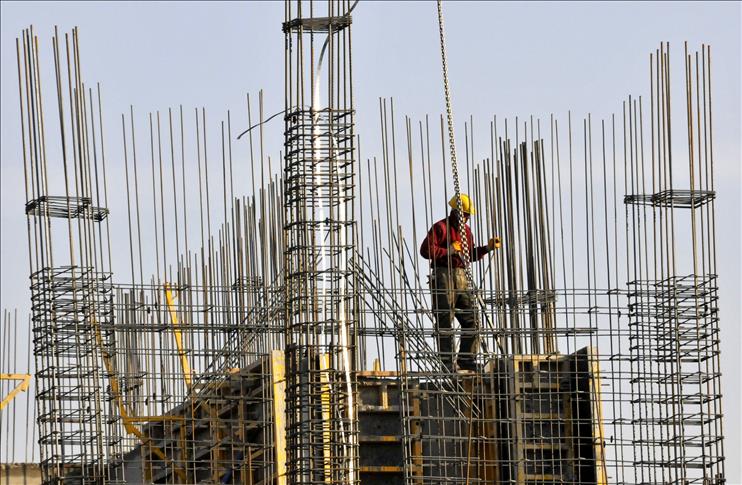
It is predicted that the construction industry in Turkey just like it is in other developing economies in 2020 will continue the tradition of positive segregation in the medium and long term. The trend of Turkey’s economic growth traditionally based on the construction and real estate market together with textile, automobile, aviation and defence industries. Yet the construction industry has a locomotive role in employment with the sectors that it interacts with.
While the overall economic confidence index increased by 14 per cent in the January-October period in 2019, the increase in the construction sector confidence index was realized as 15 per cent. As of November 2019, the October confidence index data experienced a significant recovery in Turkey, which has experienced the most stable financial climate of the recent period. The usual “high coefficient response” of the sector was also observed here. The general economic confidence index increased by 4.5 per cent in October ‘19, while the construction sector confidence index rose by 8.3 per cent. Here, the reflection of the general trend and the rapid improvement in consumer confidence indices on the construction sector also stands out as an important factor.
Housing sector
As the Turkish Statistical Institute (TÜİK) announced on Jan. 15. House sales decreased by 1.9% or 26669 units in 2019 compared to the previous year, according to data from the Turkish Statistical Institute (TurkStat). Approximately 511,700 houses were sold for the first time from January to December, while the rest were second-hand sales. You can read more details regarding the number of house sales in our article 1.35 Million Houses sold in Turkey in 2019.
Commercial real estate industry
The total demand increased to 6.46 million m² with the introduction of a new office area of 100.910 m² in Istanbul, where almost a third of the country’s economy revolves. The 78,382 sqm lease made in the last quarter of 2019 is 4.8% lower compared to the same period last year. With the acceleration of economic recovery and stability in foreign exchange rates, the rapid recovery in the third quarter of 2019 is expected to continue in 2020.
Number of Shopping Centers has not changed
The total number of shopping centres with 453 across Turkey as of year-end 2018, has not changed in the last quarter of 2019. Although this is a historical situation encountered for the first time, the number of shopping malls in the project phase was 44.
As of the last quarter of 2019, 13 million 453 thousand square meters of leasable area stock in Turkey will reach 16 million square meters with the implementation of new projects.
Shopping malls have become a part of urban life. Despite the economic difficulties and relative falling numbers of visitors, the turnover index increased by 3.5% annually in September 2019.
Touristic facilities hosted 41 million tourists
The number of tourists, which increased by 27 per cent in 2017, increased by 21.6 per cent in the first 10 months of 2018 compared to the same period of the previous year. The increase continued in the first 9 months of 2019 and reached 41 million, with a total of 14.5%.
In the third quarter of 2019, revenues increased by 22% compared to the same quarter of the previous year. During this period, with an income of 14.3 billion US dollars, the average expenditure of visitors per person was 649 US dollars. The increase in this figure, which was 612 USD in the same period of last year, can be considered as a power source for the sector. Within the scope of the New Economic Program, the tourism income target for 2021 has been determined as 42 billion USD.
In our previous article, we have announced the record in the tourism sector in 2019 which you can read in our blog. It can be said that tourism will grow in 2020 and a new record is expected in the Antalya region with at least 14 million tourists.
Mega Projects of Turkey
In the New Economic Program (YEP) announced in September 2019, it has been repeated that projects that have been or have not been tendered but whose construction has not started will be suspended. It was stated that new and extended business plans will be created for those whose financing conditions are suitable from the ongoing projects to support the construction industry in Turkey.
The latest situations in some of the existing mega projects of Turkey are as follows:
Istanbul New Airport: Istanbul Airport, which started its operations in April 2019 with the biggest moving operation in aviation history, continues to approach its potential. A total of 41.8 million passengers travelled at the New Airport between January and October 2019 with arrival and departure flights. On the other hand, it has been announced that the operator of the airport has decided to restructure the maximum amount of 5 billion Euro of IGA’s debts.
The Istanbul Financial Center: Three new contracts, totalling TL 3.7 billion, have been signed for the constructions. As the authorities stated that the construction of the project will be completed by the end of 2020, and the companies will move and start working there in 2022.
Çanakkale 1915 Bridge: The construction of the bridge, which started on 18 March 2017 and undertaken by a consortium by 4 companies, two of them Turkish and two Korean, continues. Middle opening of the bridge is identified as 2023 meters to symbolize the year of the 100th anniversary of the founding of the Republic of Turkey and the bridge will be the world’s longest suspension bridge with a clearance from the tower. Çanakkale 1915 Bridge is planned to be completed in 2023.
Canal İstanbul: The project, which came to the agenda for the first time in 2011, whose purpose was to completely close the Bosporus to tanker traffic, was postponed after the macroeconomic crisis in 2018. It was announced that the technical studies and environmental studies for the project were completed. Following the preparation of the Environmental Plan which will clearly show if there are any hazards for the environment, the tender stage will start.
City Hospitals: Although the efficiency of city hospitals has been discussed in recent days, the budget resources will continue with the use of the PPP (public-private partnership) system. Along with Ordu, Sakarya and Sancaktepe, 10 hospitals are planned to be built with state resources.
SWOT Analysis of the Construction Industry in Turkey
| Strengths
• Turkey’s geopolitical position increases the centre of attraction for Middle Eastern countries • Young population ensures continuity of housing and infrastructure investments • Cheap labour force caused by migration relatively limits the increase in costs • There are important sector representatives with international experience and institutionalism.
|
Weaknesses
• Impacts and fragility caused by the deterioration in financial conditions • Increase in the cost of building construction • Low economic confidence of individuals in the long term • Weak institutionalization in the sector • Technological developments in the world have not been caught in the sector yet |
| Opportunities
•Turkey’s being the second-largest country in the international contracting services creates a climate of trust that paved the way for all sectors • The geographical location keeps international demand alive • Natural demand is high due to the young population • Low housing ownership feeds potential demand • The government’s practices to encourage housing purchase and savings are getting stronger • The current value of TL keeps foreign demand high • The need for urban transformation creates supply appetite in the medium and long term |
Threats
• Fragility in financial markets • The sensitivity of economic trust to financial markets • Geopolitical uncertainties • The supply-demand imbalance caused by wrong investment decisions in some segments • Downward pressure on prices due to high idle capacity • The decline in oil and natural gas prices also reduces the income of energy exporting countries and this negatively affects the construction activities and the business volume of Turkish contractors. • Real value application in the land registry • Valuable housing tax application |
2020 Expectations
After a growth trend in average close to potential in Turkey sharply weakened in 2018 and in 2019. On the other hand, the recovery process of the construction industry in Turkey that started with the second half of 2019 and the growth estimates between 3% and 5% in 2020 provide an improvement in future expectations. The sector maintains its high potential in almost all areas in the long term. Short-term vulnerabilities also strive to be overcome with public support. Despite the increasing production costs, the funding costs that came down in the last period of the year are an important development for the sector’s turnover.
In this process, projects and urban transformation practices for the development of health tourism, which are also included in the New Economy Plan, are also important for the sector’s mobilization. There is another important fact that Turkey has been encountering earthquakes and as a result, the government has been transforming the old buildings into new ones. Regardless of all the crises construction sector stays alive and active in order to meet the needs of the Turkish society. Implemented urban transformation projects increase the property market of Istanbul which is helping the construction industry in Turkey to increase its share in GDP.

